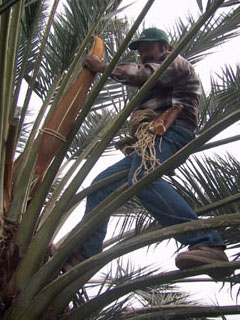How are Dates Grown?
The Date Harvest & Everything You Ever Wanted To Know About Dates
 The date season really begins early in the year when we clean up the trees after the end of the dormant period. At this time, we have to start by cutting the thorns off of the date fronds. They say that everything in the desert protects itself by stinging, biting, or poking. And the date trees are no different. They have thorns that are approximately 4 to 5 inches long, and can easily pierce thru a truck tire. So the very first thing we do is to remove the thorns to make it possible to work in the date trees.
The date season really begins early in the year when we clean up the trees after the end of the dormant period. At this time, we have to start by cutting the thorns off of the date fronds. They say that everything in the desert protects itself by stinging, biting, or poking. And the date trees are no different. They have thorns that are approximately 4 to 5 inches long, and can easily pierce thru a truck tire. So the very first thing we do is to remove the thorns to make it possible to work in the date trees.
The Sex Life of a Date
Date Palms are unique in that they are either a male tree or a female tree. The male trees produce pollen, and the female trees produce flowers. Unfortunately, neither birds or bees are attracted to the flowers, so the females have to be hand pollinated.
During the later part of February we begin to watch for the sheaths on the male trees to begin splitting open. We check each tree every single day. As soon as a sheath on a male tree begins to open, it is tied with string to hold it together, and removed from the tree.
(Notice how the worker is actually standing in the tree. Each frond can hold approximately 250 pounds.)
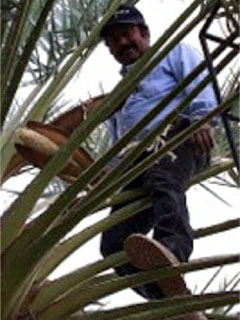 Here you get a much better view of the pollen because the sheath is split wide open. Once the sheath on the male tree opens, we will cut the whole sheath out of the tree, then hang it upside down to dry. Once the pollen has dried to a very fine powder, we sift it into a large air-tight container for storage.
Here you get a much better view of the pollen because the sheath is split wide open. Once the sheath on the male tree opens, we will cut the whole sheath out of the tree, then hang it upside down to dry. Once the pollen has dried to a very fine powder, we sift it into a large air-tight container for storage.
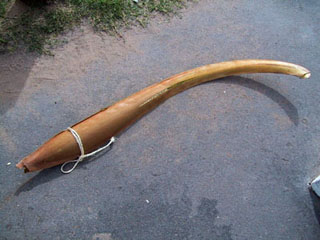 A male sheath that has been removed from the tree. Notice the small split where it is starting to break open. This sheath probably weighs close to 10 pounds.
A male sheath that has been removed from the tree. Notice the small split where it is starting to break open. This sheath probably weighs close to 10 pounds.
The Female trees have the same kind of sheath, and as they begin to flower, we will remove the sheath and separate each strand.
We then tie the strands together and hand pollinate the flowers using the fresh pollen that we have collected from the male trees. We use a small ketchup squirt bottle for this process. We pollinate each female tree at least three times.
 Around April or May, as the fruit begins to "bud" on the strands, we will begin the thinning process.
Around April or May, as the fruit begins to "bud" on the strands, we will begin the thinning process.
 First, we open up each bunch of strands that we have tied together, and cut out the middle, leaving only the outside strands. Then we remove about 60% of the dates from each strand. This allows better air flow, and the chance for each individual date to grow to it's optimum size.
First, we open up each bunch of strands that we have tied together, and cut out the middle, leaving only the outside strands. Then we remove about 60% of the dates from each strand. This allows better air flow, and the chance for each individual date to grow to it's optimum size.
It is not unusual for the temperatures to be above 100 degrees during May when we are thinning, and closer to 120 degrees during the date harvest, so most of our date workers will wear long sleeved shirts and long pants, and cover their faces with bandannas to protect themselves from both the sun and the heat.
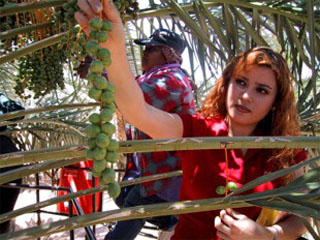 This is a strand of Medjool Dates before being thinned. By removing the majority of the dates, the ones that are left will have enough room to grow to a much larger size.
This is a strand of Medjool Dates before being thinned. By removing the majority of the dates, the ones that are left will have enough room to grow to a much larger size.
 This is the same strand of dates. As you can see, there are a lot less dates on the strand, but the number of pounds per tree will be the same, it's just that the dates will be significantly larger.
This is the same strand of dates. As you can see, there are a lot less dates on the strand, but the number of pounds per tree will be the same, it's just that the dates will be significantly larger.
Watering and Irrigating the Date Trees
Date trees take as much water as a willow tree, yet they cannot tolerate rain or humidity. That's why dates have to be grown in the hot desert, where our average rainfall is less than 3 inches per year, and our summer temperatures reach nearly 120 degrees.
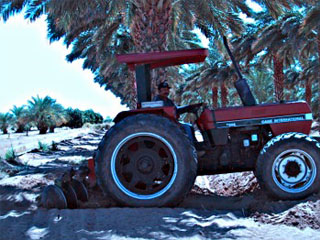 The ground around the date trees has to be kept clear of grass and weeds which cause humidity. Special "borders" are built up around the trees in order to flood irrigate and contain the water at the root of the tree.
The ground around the date trees has to be kept clear of grass and weeds which cause humidity. Special "borders" are built up around the trees in order to flood irrigate and contain the water at the root of the tree.
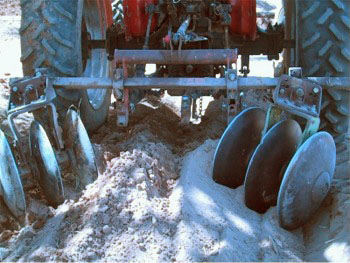 This special border disker scoops up the sand and forms a border around the date trees.
This special border disker scoops up the sand and forms a border around the date trees.
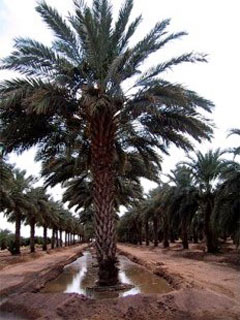 These borders keep the water where it is needed, at the root of the date trees. Each tree requires approximately 60,000 gallons of water per year, but only at its roots!
These borders keep the water where it is needed, at the root of the date trees. Each tree requires approximately 60,000 gallons of water per year, but only at its roots!
You could think of it as someone who likes to wade in the water, but doesn't want to get their hair wet!
 The borders help conserve water and eliminate grass and weeds throughout the grove.
The borders help conserve water and eliminate grass and weeds throughout the grove.
Bags & Bunches
 Our foreman is holding a small "bunch" of dates that has been cut down from the tree. Notice the thickness of the main stalk. This picture was taken early last August, before the dates had ripened.
Our foreman is holding a small "bunch" of dates that has been cut down from the tree. Notice the thickness of the main stalk. This picture was taken early last August, before the dates had ripened.
 A bunch of dates (not Medjools) just prior to the date harvest.
A bunch of dates (not Medjools) just prior to the date harvest.
 Around the beginning of August, the Medjool Dates are covered with a white muslin bag to protect the dates from birds and insects. The bags also help to catch any dates that ripen prior to the beginning of the date harvest.
Around the beginning of August, the Medjool Dates are covered with a white muslin bag to protect the dates from birds and insects. The bags also help to catch any dates that ripen prior to the beginning of the date harvest.
 Because each bunch is quite heavy, the fronds below the date bunches are positioned to help hold the weight of the dates.
Because each bunch is quite heavy, the fronds below the date bunches are positioned to help hold the weight of the dates.
Transplanting Date Pups
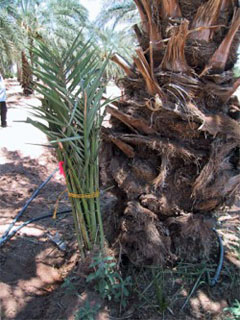 All of our date trees are grown from pups (offshoots from the parent tree). This guarantees that both the tree and the fruit produced will be identical to the parent. It takes between 6 to 8 years before the pups will be big enough to transplant, and then another six or seven years before they will begin to produce.
All of our date trees are grown from pups (offshoots from the parent tree). This guarantees that both the tree and the fruit produced will be identical to the parent. It takes between 6 to 8 years before the pups will be big enough to transplant, and then another six or seven years before they will begin to produce.
To make it easier to separate the pups from the parent tree, we have attached a special chisel to the backhoe. The backhoe can exert quite a bit more force then an individual worker.
 A date pup partially separated from it's parent tree.
A date pup partially separated from it's parent tree.
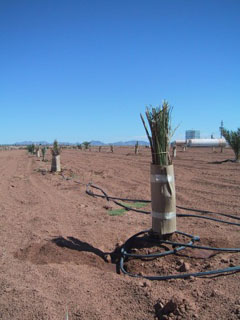 After the new pups have been planted, they are given a "flat top" haircut, and wrapped in cardboard to protect the heart. They will receive a constant flow of water thru a drip irrigation system.
After the new pups have been planted, they are given a "flat top" haircut, and wrapped in cardboard to protect the heart. They will receive a constant flow of water thru a drip irrigation system.
The Date Harvest
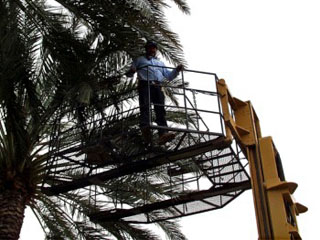 Although many date farms still use ladders, we use a U-Shaped basket on a forklift to reach the dates. We will be able to utilize this method until the trees are approx. 40 ft. tall.
Although many date farms still use ladders, we use a U-Shaped basket on a forklift to reach the dates. We will be able to utilize this method until the trees are approx. 40 ft. tall.
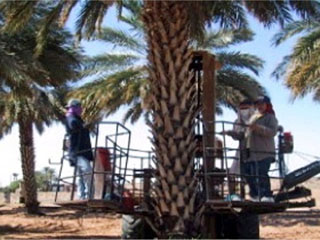 The forklift will be parked at the base of the tree, so that the tree trunk is positioned between the forks. The basket will then be lifted to an appropriate height so the dates can be easily harvested.
The forklift will be parked at the base of the tree, so that the tree trunk is positioned between the forks. The basket will then be lifted to an appropriate height so the dates can be easily harvested.
As the basket is being lifted into the tree, the pickers are holding plastic trays that will be suspended from a branch so that they will hang underneath the date bunches while they harvest the dates.
 Once the trays are in place the pickers will untie the bottom of the bags covering the dates and shake out any dates that have already ripened and fallen off the strands.
Once the trays are in place the pickers will untie the bottom of the bags covering the dates and shake out any dates that have already ripened and fallen off the strands.
(If you look at the bag to the far left side of the picture, you can see that all of the dates have ripened and fallen to the bottom of the bag. This is unusual, as most Medjool dates have to be individually removed from the strands by hand.)
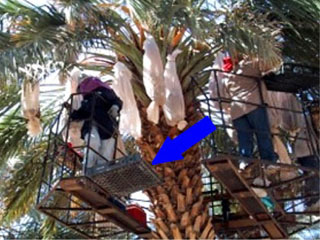 Once the tray is full, it will be lowered down and an empty tray will be sent back up.
Once the tray is full, it will be lowered down and an empty tray will be sent back up.
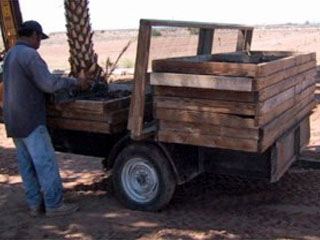 The full trays will be emptied into a larger screened tray, then taken to the processing area for sorting.
The full trays will be emptied into a larger screened tray, then taken to the processing area for sorting.
 The dates are brought in from the grove in either these large wooden screen trays, or else in smaller black plastic trays.
The dates are brought in from the grove in either these large wooden screen trays, or else in smaller black plastic trays.
 Most of the dates come in from the grove already ripe, but occasionally we get some that are still yellow. These yellow dates have to be left out in the heat (not the sun) to finish ripening.
Most of the dates come in from the grove already ripe, but occasionally we get some that are still yellow. These yellow dates have to be left out in the heat (not the sun) to finish ripening.
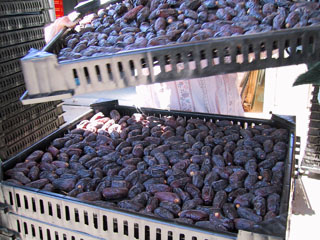 (We do receive a lot of requests for "yellow dates" but we don't sell them at that stage because it is impossible to guarantee that the dates will not have finished ripening by the time they are received.)
(We do receive a lot of requests for "yellow dates" but we don't sell them at that stage because it is impossible to guarantee that the dates will not have finished ripening by the time they are received.)
 The dates that have to be left in the heat to ripen have to be sorted individually as each date will ripen at its own pace.
The dates that have to be left in the heat to ripen have to be sorted individually as each date will ripen at its own pace.
 The dates are then emptied from the trays onto a shaker table that rocks gently back and forth. The table is covered in wet terry cloth towels. As the dates roll very slowly down the table, they are cleaned by the wet towels. (Of course, the towels are changed frequently throughout the day.)
The dates are then emptied from the trays onto a shaker table that rocks gently back and forth. The table is covered in wet terry cloth towels. As the dates roll very slowly down the table, they are cleaned by the wet towels. (Of course, the towels are changed frequently throughout the day.)
 The dates then roll onto a conveyor belt where they will be sorted by size and quality.
The dates then roll onto a conveyor belt where they will be sorted by size and quality.
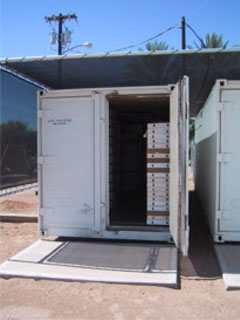 From there the dates are then packed and moved into cold storage until they are sold.
From there the dates are then packed and moved into cold storage until they are sold.

